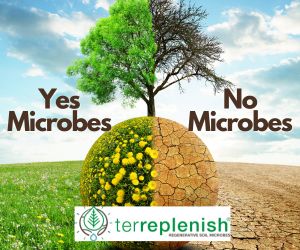The Soil’s Addiction: How Soil Regeneration Depends on Soil Life for Moisture and Fertility

Imagine a garden, lush with vibrant plants, thriving under the warm embrace of the sun. Now, picture a desolate wasteland, where the earth has turned to dust, incapable of nurturing life.
What’s the key difference between these two scenarios?
The answer lies beneath the surface – in the intricate web of soil life.
Soil regeneration is the process that sustains fertile and moisture-rich soil, hinges on the health and vitality of the microorganisms that inhabit it.
In this blog, we will explore the critical relationship between soil life, moisture retention, and fertility, drawing an analogy to soil’s addiction to petrochemicals, which gradually weakens its microbiotic system and structure, ultimately turning it into dust.
The Vital Role of Soil Life
Before delving into the analogy of soil addiction, it’s essential to understand why soil life is indispensable for soil regeneration. Beneath our feet, an invisible world teems with life – bacteria, fungi, protozoa, nematodes, and earthworms. These organisms form the foundation of healthy soil and are collectively referred to as the soil microbiome.
Moisture Retention: Soil life plays a vital role in moisture retention. Healthy soil is akin to a sponge, capable of holding and slowly releasing water. The secret behind this lies in the organic matter created by soil organisms. When microorganisms break down organic matter like decaying leaves and plant debris, they create humus – a stable form of organic matter. Humus acts as a moisture sponge, storing water and preventing it from evaporating too quickly. It forms a reservoir that plants can tap into during dry spells, ensuring they have a constant water supply.
Nutrient Cycling: Soil organisms are nature’s recyclers. They break down complex organic compounds into simpler forms that plants can absorb. This nutrient cycling is essential for plant growth. When plants die, the nutrients in their tissues are returned to the soil through decomposition, and this process is orchestrated by soil life. Without these microorganisms, nutrients would become locked up in dead plant material, rendering them unavailable to new growth.
Soil Structure: Soil structure is crucial for water infiltration and root growth. Soil life contributes to the formation of stable soil aggregates, which create pore spaces in the soil. These pore spaces allow water to penetrate the soil, reducing runoff and erosion. Additionally, they provide room for plant roots to grow and access both water and nutrients.
The Soil’s Petrochemical Addiction
To better grasp the importance of soil life, let’s draw an analogy between soil and addiction. Imagine soil as an individual hooked on petrochemicals, such as synthetic fertilizers and pesticides. At first, these chemicals seem like a quick fix, boosting plant growth and eliminating pests. However, over time, the soil becomes increasingly reliant on these artificial crutches, just as an addict depends on a substance to function.
Short-Term Gains: Petrochemicals can deliver impressive short-term results. Synthetic fertilizers provide plants with a quick supply of essential nutrients, resulting in rapid growth. Pesticides can swiftly eliminate pests that threaten crops. Similarly, an addict experiences a temporary high, feeling better for a short time after using their substance of choice.
Dependency: Just as an addict becomes dependent on their substance, soil treated with petrochemicals relies on them for sustenance. Synthetic fertilizers can disrupt the natural nutrient cycling process, making plants less self-sufficient. Pesticides can harm beneficial insects and microorganisms, leaving the soil ecosystem imbalanced.
Weakening the Microbiotic System: Over time, the soil’s addiction to petrochemicals weakens its microbiotic system. Synthetic fertilizers can alter the soil’s pH, making it less hospitable to beneficial microorganisms. Pesticides can kill off essential soil organisms, disrupting the delicate balance of life beneath the surface.
Structural Degradation: Just as an addict’s health deteriorates with substance abuse, soil structure degrades with the overuse of petrochemicals. The soil’s ability to retain moisture diminishes, leading to increased runoff and erosion. The loss of soil structure also impedes root growth, making plants more susceptible to drought.
The Path to Soil Regeneration
Breaking the soil’s addiction to petrochemicals is the first step towards soil regeneration. It’s akin to rehabilitating an addict – a challenging but essential process. Here’s how we can kickstart the journey:
Reduce Chemical Dependency: Gradually reduce the use of synthetic fertilizers and pesticides. Implement organic farming practices that work with nature, not against it. Organic farming relies on soil life to nourish plants and control pests, promoting a healthier soil ecosystem.
Build Organic Matter: Just as addicts need a support system, soils require organic matter to thrive. Incorporate organic materials like compost, cover crops, and crop residues into the soil. This provides a steady supply of food for soil organisms, enhancing their populations and activity.
Encourage Biodiversity: Biodiversity is the key to a resilient soil ecosystem. Plant diverse crops, rotate them regularly, and maintain hedgerows and wild areas to encourage a variety of beneficial organisms. This diversity helps balance the soil ecosystem and reduces the need for chemical interventions.
Practice Conservation: Just as an addict must protect their newfound sobriety, we must protect our regenerating soil. Implement soil conservation practices like no-till farming, mulching, and reduced irrigation. These techniques minimize soil disturbance and preserve the gains made in soil health.
In conclusion, soil regeneration is not a luxury but a necessity for the future of agriculture and our planet. To nurture fertile, moisture-retentive soil, we need free-living Microbial products like Terreplenish Regenerative Soil Microbes to help break the soil’s addiction to petrochemicals. This analogy underscores the urgency of adopting sustainable farming practices that prioritize the well-being of the soil microbiome. As we wean the soil off its chemical dependence and foster a healthy microbial ecosystem, we pave the way for a future where our land remains fertile and resilient, capable of sustaining life for generations to come. #soil #regeneration #environment #terreplenish
